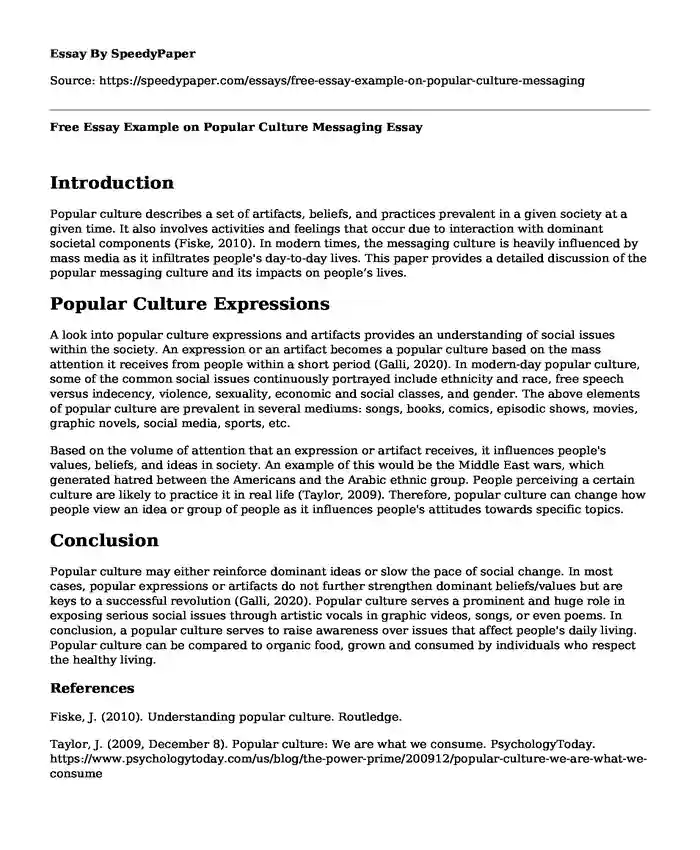Introduction
Popular culture describes a set of artifacts, beliefs, and practices prevalent in a given society at a given time. It also involves activities and feelings that occur due to interaction with dominant societal components (Fiske, 2010). In modern times, the messaging culture is heavily influenced by mass media as it infiltrates people's day-to-day lives. This paper provides a detailed discussion of the popular messaging culture and its impacts on people’s lives.
Popular Culture Expressions
A look into popular culture expressions and artifacts provides an understanding of social issues within the society. An expression or an artifact becomes a popular culture based on the mass attention it receives from people within a short period (Galli, 2020). In modern-day popular culture, some of the common social issues continuously portrayed include ethnicity and race, free speech versus indecency, violence, sexuality, economic and social classes, and gender. The above elements of popular culture are prevalent in several mediums: songs, books, comics, episodic shows, movies, graphic novels, social media, sports, etc.
Based on the volume of attention that an expression or artifact receives, it influences people's values, beliefs, and ideas in society. An example of this would be the Middle East wars, which generated hatred between the Americans and the Arabic ethnic group. People perceiving a certain culture are likely to practice it in real life (Taylor, 2009). Therefore, popular culture can change how people view an idea or group of people as it influences people's attitudes towards specific topics.
Conclusion
Popular culture may either reinforce dominant ideas or slow the pace of social change. In most cases, popular expressions or artifacts do not further strengthen dominant beliefs/values but are keys to a successful revolution (Galli, 2020). Popular culture serves a prominent and huge role in exposing serious social issues through artistic vocals in graphic videos, songs, or even poems. In conclusion, a popular culture serves to raise awareness over issues that affect people's daily living. Popular culture can be compared to organic food, grown and consumed by individuals who respect the healthy living.
References
Fiske, J. (2010). Understanding popular culture. Routledge.
Taylor, J. (2009, December 8). Popular culture: We are what we consume. PsychologyToday. https://www.psychologytoday.com/us/blog/the-power-prime/200912/popular-culture-we-are-what-we-consume
Galli, M. (2020, June 27). Looking closely at popular culture messaging. ResearchGate. https://www.researchgate.net/publication/342697543_Looking_Closely_at_Popular_Culture_Messaging.
Cite this page
Free Essay Example on Popular Culture Messaging. (2023, Dec 12). Retrieved from https://speedypaper.net/essays/free-essay-example-on-popular-culture-messaging
Request Removal
If you are the original author of this essay and no longer wish to have it published on the SpeedyPaper website, please click below to request its removal:
- The Social Media Essay Sample
- Effects of Social Media on Teenage Kids, Free Essay Example
- Essay Example: Business Communication and Corporate Culture in India
- Essay Example on Leadership Techniques on the Movie Gladiators
- Free Essay Sample on Superconnected
- The Examination of Leadership Taxonomies - Free Paper Example
- Article Review Example: Why Are We Losing All Our Good People?
Popular categories





